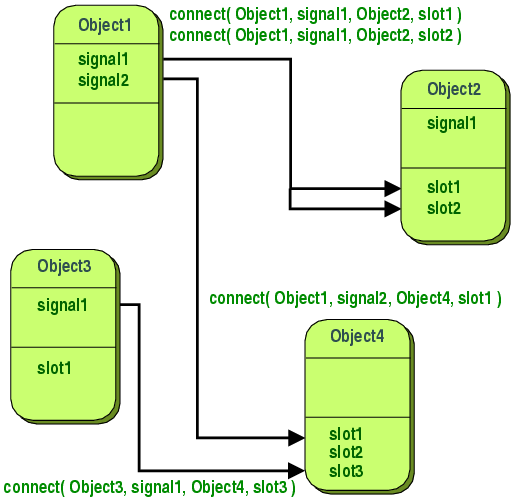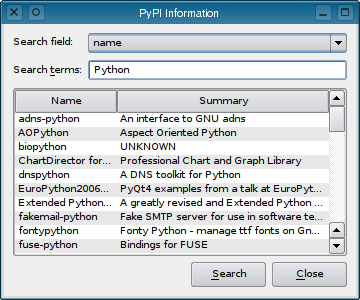How To Use Pyqt Signals And Slots
- QGIS 3 Plugins - Signals and Slots in PyQt; QGIS 3 Plugins - Plugin Development Part 1; QGIS 3 Plugins - Plugin Development Part 2; QGIS 3 Plugins - Set up Plugin Repository; QGIS 3 Plugins - Signals and Slots in PyQt. This is a brief explanation of the concept of signal and slot in PyQt5, which is the GUI framework for QGIS plugins.
- The Signal class provides a way to declare and connect Qt signals in a pythonic way. PySide adopt PyQt’s new signal and slot syntax as-is. The PySide implementation is functionally compatible with the PyQt 4.5 one, with the exceptions listed bellow.
- PyQt5 uses a unique signal and slot mechanism to handle events. Signals and slots are used for communication between objects, and when a particular event occurs, the signal is fired. The slot can be any Python call. The connection to the slot is called while the signal is transmitting. Signals & slots. Here’s a simple example to demonstrate.
- How To Use Pyqt Signals And Slots Using
- Pyqt Signals And Slots
- How To Use Pyqt Signals And Slots Key
- How To Use Pyqt Signals And Slots Games
- How To Use Pyqt Signals And Slots Free

Each PyQt widget, which is derived from QObject class, is designed to emit ‘ signal ’ in response to one or more events. The signal on its own does not perform any action. Instead, it is ‘connected’ to a ‘ slot ’. The slot can be any callable Python function. @Praanesh This has been asked before. There is no such as 'a hexadecimal value', as a type, not in C and not in Python. Either you have a number (integer) or perhaps you have a string which is a representation in hex of a number.
Design multiple windows in designer
To jump, of course, there must be multiple windows, so we design another window in designer. When we click the login button in the main interface, we will jump to this window.
The method is the same. Drag the control, save it as a. ui file after it is designed, and then convert the. ui file to a. py file.
They are connected by signals and slots
What are signals, slots?
This is a feature of designer. The user will send a signal to guide the slot function to complete the corresponding action. Too abstract, for example.
The code for the main window looks like this.
The above statement to complete the window jump is as follows.
signal
Slot function
How To Use Pyqt Signals And Slots Using
So to complete the jump, we have to go through the following steps:
1. Add signals and slots
On the control where you want to add a signal, add a statement. For example, we add a signal to the login button with the object name as the pushButton to connect to the open() slot function, which is used to open a new window.
- self: for UI_ Instantiation object of MainWindow
- pushbutton: the object name of the login button
- Click: signal means to send the signal to the slot function when the user clicks the login button
- Slot and signal connection functions: connect
- open: slot function, that is, after receiving the signal, the function is called.
- Import: is the name of the new window, tiaozhuan.py .
In addition, when opening a new window, we need to close the original login window. In the same way, add a signal on the login button.
signal
Slot function
It is important to note that the close() method must be called with the real instantiated object when closing the window. It can't be replaced by self.

2. Modify the called window
Two modifications are needed:
class Ui_MainWindow(QMainWindow): change the object to QMainWindow
def __init__(self): ා add initialization function super (UI)_ MainWindow,self).__ init__ () self.setupUi (self)
Add initialization function to class
3. Run the main window
Directly run the main window, you can see the heart of the GUI!
Note: in this case, if you want to run the program, you have to add a file.
Because in the tiaozhuan.py In this window, we introduce three pictures. How to solve this problem, put the resource file in the tiaozhuan.py File in the same directory.
Resource file code link: (put a piece of words, the article is too long to send out... )
https://download.csdn.net/download/leidawangzi/13613277
How to get the resource file? Moving on to the next section, we'll learn how to add pictures to the control.
Bibliography: Python GUI design (PyQt5 from introduction to practice) - tomorrow Technology
This article mainly introduces PyQt5 daily must learn events and signals related information, has some reference value, interested partners can refer to
In this section we will explore how PyQt5’s events and signals are implemented in the application.
Book: Create Desktop Apps with Python PyQt5
Events
All GUI applications are event-driven. Application events are generated primarily from users, but they can also be generated by other means, such as an Internet connection, a window manager, or a timer. When we call the exec_() method of the application, the application enters the main loop. The main loop detects various events and sends them to the event object.
Pyqt Signals And Slots
In the event model, there are three participants.
- event source
- event object
- event target
An event source is a change in the state of an object that generates an event. An event object (event) is an object that encapsulates a state change in the event source. The event target is the object that wants to be notified. The event source object represents the task of processing an event to the event target.
PyQt5 uses a unique signal and slot mechanism to handle events. Signals and slots are used for communication between objects, and when a particular event occurs, the signal is fired. The slot can be any Python call. The connection to the slot is called while the signal is transmitting.
Signals & slots
Here’s a simple example to demonstrate PyQt5’s signal and slot.

In our example, QtGui.QLCDNumber and QtGui.QSlider will be used. we change the LCD numbers by dragging the slider.
Here, the slider’s valueChanged signal is connected to the LCD’s display (display) slot.
A transmitter is an object that sends a signal. The receiver is the object that receives the signal. What slots is the method of feedback to the signal.
Overwrite the system event handler. You can use any key to fire an event.
In the example below the escape key triggers an event that quits the program.
In our example, we reimplement the keyPressEvent() event handler.
If we press the Esc key on the keyboard, the application terminates.
Book: Create Desktop Apps with Python PyQt5
Event sender event send
To facilitate differentiation of multiple event sources connected to the same event target, the sender() method can be used in PyQt5.
In our example there are two buttons. Both buttons are connected to the buttonClicked() method and we respond to the clicked button by calling the sender() method.

How To Use Pyqt Signals And Slots Key

The two buttons are connected to the same slot.
We determine the signal source by calling the sender() method. In the application’s status bar, the label of the button that was pressed is displayed.
How To Use Pyqt Signals And Slots Games
Customized emission signals
An object created from a QObject can signal. In the following example, we’ll look at how we can customize the signal sent.
We create a new signal called closeApp. This signal is emitted by the mouse press event. This signal is connected to the close() slot in QMainWindow.
How To Use Pyqt Signals And Slots Free
Creates a Communicate class inherited from QObject, which has a property of the pyqtSignal() class.
Connect our custom closeApp signal to the close() slot in QMainWindow.
The CloseApp signal is emitted (emit) when our mouse clicks in the program window: application termination.
Book: Create Desktop Apps with Python PyQt5